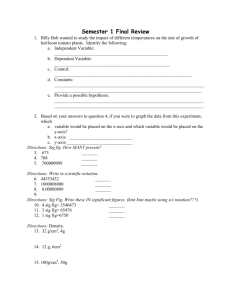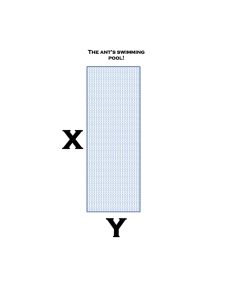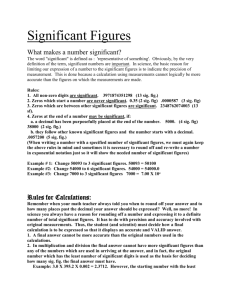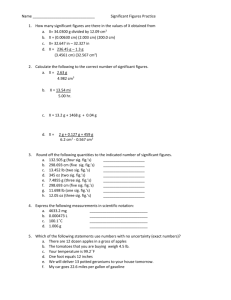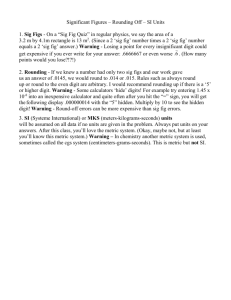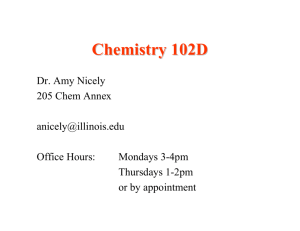I. Chemistry and the Scientific method
advertisement
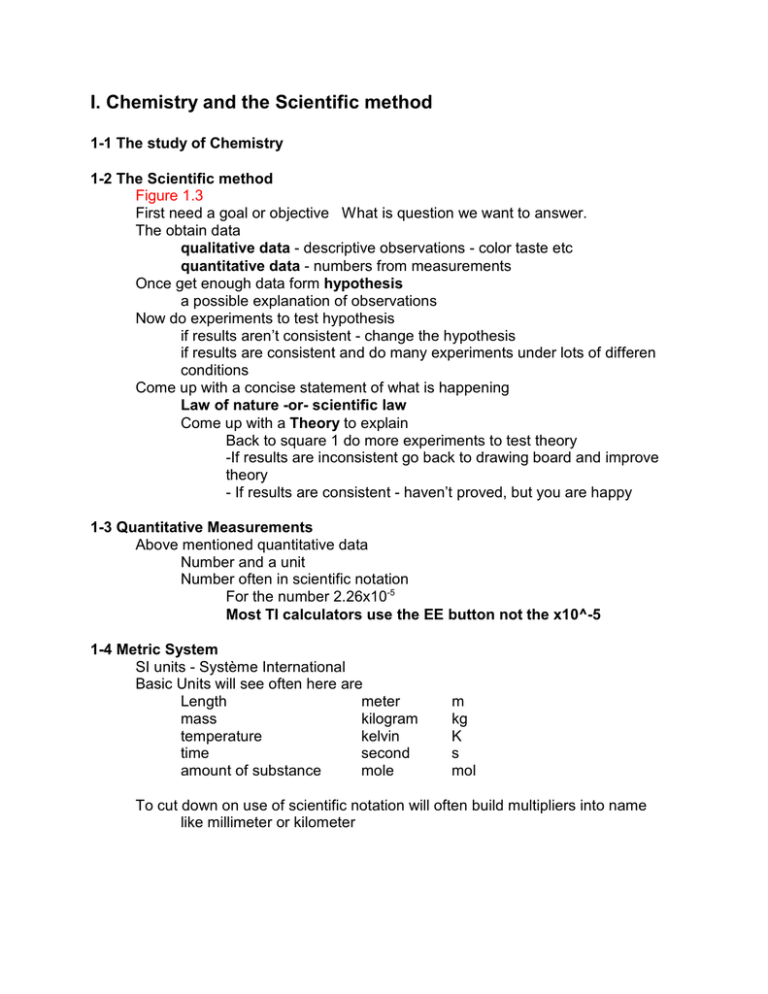
I. Chemistry and the Scientific method 1-1 The study of Chemistry 1-2 The Scientific method Figure 1.3 First need a goal or objective What is question we want to answer. The obtain data qualitative data - descriptive observations - color taste etc quantitative data - numbers from measurements Once get enough data form hypothesis a possible explanation of observations Now do experiments to test hypothesis if results aren’t consistent - change the hypothesis if results are consistent and do many experiments under lots of differen conditions Come up with a concise statement of what is happening Law of nature -or- scientific law Come up with a Theory to explain Back to square 1 do more experiments to test theory -If results are inconsistent go back to drawing board and improve theory - If results are consistent - haven’t proved, but you are happy 1-3 Quantitative Measurements Above mentioned quantitative data Number and a unit Number often in scientific notation For the number 2.26x10-5 Most TI calculators use the EE button not the x10^-5 1-4 Metric System SI units - Système International Basic Units will see often here are Length meter mass kilogram temperature kelvin time second amount of substance mole m kg K s mol To cut down on use of scientific notation will often build multipliers into name like millimeter or kilometer 2 Common multipliers are show in Table 1.2 The ones you need to know are: KEY CONCEPT - Know : G, M, k, c, m, ì, n (forget p, f, and a for Gen Chem) Clicker question - match multiplier and exponent Practice problems: Express 500 nm in meters using scientific notation 500 x 10-9 m Express 2.35 Gbytes in scientific notation 2.35 x10+9 bytes Volume To be consistent, you would think the SI unit of volume would be m3. However that is not terribly convenient because it is a large volume. We use: 1L = (10cm)3 = 1000 cm3 and 1 mL = 1 cm3 (or sometime 1cc) Mass mass is a measurement of object inertia or resistance to being moved weight is a measurement of an objects attraction to the planet it is on. The book will be nice and consistent and always use the term mass Your instructor, on the other hand is not so consistent, and will frequently use the term weight, when he should be using the term mass. Temperature We will only use Kelvin and Celsius temperature scales in this class, and you will need to know how to convert between them. Do not bother with conversions to or from Fahrenheit. KEY EQUATION: T(in K) = t (in oC) + 273.15 3 Practice problem: Express 4K (the temperature of liquid Helium) in oC 4T(K) = t(oC) +273.15 4K -273.15 =t -260.15 oC Express 25 oC (room temperature) in K T(K) = 25oC + 273.15 =298.15K Clicker question: T6C, C6T Compound units Many times properties are expressed as compound units, things like Density = mass/volume Or Pressure = force/surface area The units of these compound units can be expressed in different ways, for instance: The density of gold is 9.32 g/cm3 But 1/cm3 = cm-3 So you may also see g @cm-3 Note the dot in the above example is significant Compare the following two units 5.9 ms and 5.9m@s When there is no dot indicating a multiplication 5.9ms then you use the milli abbreviation =5.9x10-3 second When there is a dot indicating a multiplication 5.9 m@s = 5.9 compound unit of meters x seconds Intensive vs extensive properties KEY CONCEPTS: Extensive properties are properties like mass or moles that are directly proportional to the amount of material present. (Depend on the extent of the material) Intensive properties like density or temperature are independent of the amount of material present 4 1-5 Units of Energy Energy Energy is the ability to do work or to change a physical system It is another compound unit that we will explore briefly now, and in much more depth in chapters 14 and 23. You are probably already familiar with two forms of energy: Kinetic Energy - the energy associated with a moving object Potential Energy - The energy associated with location in a force field and you are familiar with the law of conservation of energy: During any physical process, energy cannot be created or destroyed Kinetic energy is calculated using the equation E=1/2 MV2 if M is mass , units of kg V is velocity - units of m/s or m@s-1 So Kinetic energy has units of kg@m2@s-2 Rather than writing kg@m2@s-2, we use the unit of 1 joule 1J=1 kg@m2@s-2 The potential energy in a gravity field is given by the equation: E = mgh where m is mass (kg) g is gravitational acceleration constant (m@s2) And h is height above the ground Guess what our units are: kg x (m@s2) x m = kg@m2@s-2 (as you should expect, since energy is energy) Rate of energy production How fast energy is produced or used is another compound unit that you have heard of, the watt A watt is 1 joule produced or used in 1 second So it would have units of J/s or J@s-1 or kg@s2@s-2@s-1 or kg@s2@s-3 5 1-6 Accuracy and Percentage Error Now that we have played with the units of a quantitative measurement, lets return and have a second look at the number part of the quantitative data. Some numbers are determined simply counting the number of objects, and you will always have whole counting numbers as a result. (Like there are 24 students in section 2 of the lab Other numbers involve measurements, and the these measurements do not give nice whole counting numbers, and sometimes these measurements are not exactly the same from one measurement to the next. Let’s explore these kinds of data, where the numbers are not the same from one measurement to the next. We use two words to describe what goes on here. KEY CONCEPTS Accuracy refers to how close our number is to the actual value. Precision refers to how close our numbers are to each other. The difference between accuracy and precision can be easily illustrated with arrows hitting a target. Show examples of high precision, low precision, high accuracy low accuracy Accuracy One way to measure accuracy is with percentage error: KEY EQUATION: percentage error = (average value-true value)/true value x 100% 6 Sample calculation: I was given a sample this summer that was supposed to contain 10 ng Vitamin B1/gram of sample. When I analyzed this sample I found that it contained 9.6 ng B1/g of sample. What was my %^ error percent error = (9.6-10.0)/10.0 x 100 % = -4% error If I had a +.1% error, what would my average error be? +.1% = (X-10.0)/10.0 x 100% .1/100 = .001 = (X-10.0)/10.0 .001(10.0) = (X-10.0) .01 = X-10.0 .01 + 10.0 =X Average value = 10.01 ng B1/g of sample Clicker question on calculation of % error: Give some numbers, and look to see if can set up equation 1-7 Precision as indicated by Significant Figures Precision, or how closely grouped together your numbers are, can be measured by various statistics that allow you to assign a ±number to convey the uncertainty in your number. I don’t want to get into these statistics in this class, so instead we will use significant figures to convey a rough idea of the precision in a number. In writing a number, the idea is that the last digit in any written number is the one that is uncertain, and that all the other digits are certain (also called significant) Because zeros are often included in a written number as a place holders rather than to show precision, zeros can be messy. So we will use the following rules to count the number of significant figures in a written number. 1. Every non-zero digit in a number is counted as significant. 1235 has 4 significant figures 2. Zeros are a bit trickier A. Leading Zeros (preceding a number) are not significant (.002354 has 4 sig fig) B. Captive zeros are significant (.0020354 has 5 sig fig) C. Following zeros (following a number) are significant only if the number contains a decimal point (20354000 has 5 sig fig, 20354000. has 8 sig fig, .002035400 has 7 sig fig) 7 3.Exact Numbers Counting numbers (5 experiments, 6 MM's) or exact constants (the 2's in A=2 ðr2 ) are considered to be infinitely precise. Also 100 cm = 1m, 4. When in doubt use Exponential Notation to express the number of sig fig exactly. Clicker question: Give a few numbers and check the sig figs 1-8 Significant figure in calculations Many of the numbers that we derive in science are not a simple single measurement, but are the result of a calculation where one uncertain number is combined with another uncertain number. How do we determine the uncertainty in this case? Again there are good calculations based on math and statistics that you will use in a more advanced course like Analytical Chemistry, but in this class we will use some simple rules that work almost as well without the math. Rules for sig fig in calculations 1. For Multiplication or Division # of Sig fig in a calculation = # sig fig in the least precise number used in calculation (IE the one with smallest # of sig fig (round to that level) example 40 mmol/0.100 l =? - 40 1 sig fig; 0.100 3 sig fig - 40/0.1 = 400 mmol/l or 0.4 mol/l or 0.4M (1 sig fig) 2. Addition or subtraction Line all the numbers up along the decimal point. The answer will round to same decimal value as least precise number. example 1.0054g - .02g = .9854 by calculator, .99 by sig fig (2) Now what about rounding? I expect you know how to round, if the number to be removed is <5 round down if is =or > 5 round up. (this is what calculators do.) Note - look only at the digit immediately to the right of the last sig fig, don't go any farther. (i.e. don’t work back from end – 0.549 rounds to .55 or .5. not to .55 and then to .6) 8 One final note on rounding. DO NOT ROUND OFF INTERMEDIATE CALCULATIONS Especially on a test. DON”T ROUND UNTIL THE END!!! Clicker question on sig fig in a multiplication and an addition problem 1-9. Dimensional Analysis Now lets go back to the units on our measurement. What do you do when you have calculated an answer in one unit, but you need the answer in some other unit? You use a unit conversion factor and dimensional analysis to convert from one unit into another. Say the evil Dr. Z want to know the length of a football field in meters instead of yards. First write down what you know 1 football field = 100 yards Next write down the units you want I want units of meters Now find unit conversion factor that contains units for both! Slide of conversion factors you will be given 1 meter = 1.0936 yards If you divide the left side by the right side you get one conversion factor And this can be used to convert yards 6 meters If you divide the right side by the left side you get a different conversion factor And this can be used to convert from m6yds How do you know which one to put on top and which to put on the bottom? You choose the conversion that will cancel the unwanted unit from the calculation 9 Now remember those metric multipliers I told you to memorize? Lets throw them into the problem as well and have you find the length of the football field in cm! How do you do this? First what is a cm ? It is a centimeter What is the relationship between a centimeter and a meter? 1 Centi =1x10-2 so 1 cm = 1x10-2m (Simply substitute the multiplier in for the word!) Now lets add that conversion factor to the previous conversion factor Mrs. Z. Like to use the phrase “railroad tracks” set up the railroad tracks, arrange the units to cancel, then run the calculation. Next level of difficulty multiple units: I can walk about 3 miles per hour. What is that in meters/second? Notice here we have two different units in two different locations to convert. Miles to meters in the numerator and hours to seconds in the denominator. Let’s start in the numerator Now let’s work on the denominator. Notice that to cancel thing out in the 10 denominator we have to flip our conversion factors upside-down Actually the way you should really to this is in one single calculation with no rounding off in an intermediate calculation Now lets go for something more abstract to see if you have it. What is my walking pace in furlong/fortnight? Starting mathematically 3 mi/hr = ? Fr./fn Here are some constants we might need fl=220 yd 1 mi= 1760 yd 1 fn=14 days 1 day=2 4h Note speed is composed of two fundamental units distance/time. Let’s work on one at a time, starting with distance. a furlong is 220 yards a fortnight is 14 days, a mile is 1760 yards so we have 1 mile is 1760 yds; 3 mi/hr X 1760 yd/mi = yd/hr (convert mi to yd) 220 yd = fl so 3 mi/hr X 1760 yd/mi X 1 fl/220 yd (convert yd to fl) We now have furlongs where we want it. How about the hour in the denominator? /h X 24h/day = /day /day X 14 day/fn = /ft Putting all together 3 mi/hr X 1760 yd/mi X 1 fl/220 yd X 24 hr/day X 14 day/ft 8,064 furlongs/fortnight! 11 There is a second conversion problem that you have to be aware of. What happens when your unit has an exponent associated with it, like lbs/in2 ? Example - Conversion of 32 lbs/in2 to kg/m2 Conversion factors 2.54 cm = 1 in 1 kg = 2.2046 lbs 32 lbs/in2 × (1kg/2.2046 lbs) Get rid of lbs, put in kg 2 32 lbs/in × (1kg/2.2046 lbs) × (1in/2.54 cm) Get rid of in and put in cm But notice what happens if we stop here. We have only canceled out 1 of 2 inch units, so our units are 5.71 kg/(in@m) !! Lousy units So if there is a power associated with a unit you need to do that conversion multiple times!! The actual answer should be: 32 lbs/in2 × (1kg/2.2046 lbs) × (1in/2.54 cm) × (1in/2.54 cm) × (100cm/m) × (100cm/m) =22.498 kg/m2 22 kg/m2 if you pay attention to significant figures KEY EQUATION: if 1 stuff = 10 junk and 100 junk = 1Mgarbage 5.7x103 stuff 6garbage Click question: Give some set-ups for unit conversions 1-10 Guggenheim notation Skip!!
